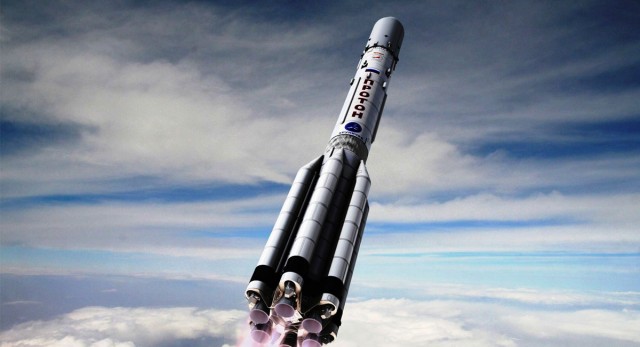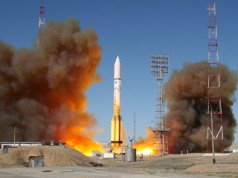Russia has successfully launched a rocket of Proton-M type, which put into space a British satellite. It was the first launch of the rocket of that type since the accident occurred in May, which resulted in crashing the Mexican communications satellite.
According to the Russian Space Agency, the rocket Proton-M, carrying the communications satellite Inmarsat-5 F3, was launched from the Baikonur Cosmodrome in Kazakhstan according to schedule, i.e at 11:44 GMT.
During the launch there was no emergency situation, as stated by Igor Burenkov, a spokesman for the Russian Space Agency Roskosmos, in his interview with AFP. – All systems operated surprisingly fine.
This launch is of crucial importance for the company Inmarsat, which is the largest satellite operator in the UK, stating that by operating along with another two similar satellites the new spacecraft will create the world’s first global high-speed broadband service of one provider.
Due to three Ka-band satellites in orbit, the Inmarsat Company will be able to provide reliable coverage of a high speed internet signal on the ground and in the sky, even in the most remote corners of the planet. Internet by Global Xpress, which enables receiving data at the maximum speed of 50 Mbit/s and sending data at the speed of 5 Mbit/s, is hundred times faster than the current Internet by SwiftBroadband, provided via L-band, what makes it possible to ensure continuous communication with aircraft even while passing through several time zones.
The increase in available speeds also improves the ability to view web sites, linear TV programs and TV on demand, expanding the horizons of available entertainment while travelling by plane.
The option of providing broadband services appeared at the company Inmarsat due to its cooperation with terminal manufacturers like Honeywell, Kymeta, ARINC Direct, Gogo and OnAir, as well as its work with manufacturers of aircraft, aimed at harmonizing the existing and upgraded vehicles.
Although the emergence of a new space Internet in the passenger cabin of commercial airlines can be expected to start this year, the Inmarsat plans to launch into space another satellite, to be safe. The fourth satellite, Inmarsat-5 F4, is actually under manufacture.
The satellite remains under manufacture of the Boeing Satellite Systems International, the same company that designed all the previous satellites of Inmarsat-5 family, and it will be launched into space next year by Elon Musk’s SpaceX Company. However, the Inmarsat has not definitively decided whether to reserve its fourth satellite, or whether to use it for increasing capacity and coverage of the system.
The first satellite of the Global Xpress Service, Inmarsat-5 F1, was launched in December 2013, providing coverage of Europe, Middle East, Africa and Asia. The second vehicle, Inmarsat-5 F2, went into space in February 2014, providing coverage of the North and South America, as well as the water area of the Atlantic Ocean.

















